What’s the Big Deal About Belgium?
There’s a common trajectory among many enthusiasts’ love affair with beer. The casual drinker—and this is a huge generality and is by no means meant to be a definitive rule—tends to equate brewing greatness with one country: Germany. And there’s nothing wrong with that. As you’ve already read, Germany is one of the world’s foremost beer cultures, and it’s responsible for so much of what we’re drinking today.
However, as the beer-curious get a little deeper into the subject, they begin to become fixated on another European country, one that had barely been on their radar, save for any thoughts related to waffles and chocolate. The moment many drinkers discover Belgian beer, their entire worldview shifts. A common first exclamation is along the lines of “Wow! I didn’t know beer could taste like that.” Even upon this revelation, they’ve barely just scratched the surface.
Entire books—series of books, even—have been written on the stylistic traditions that have emerged over the centuries in the tiny Western European country of Belgium, and even what these books cover is just the tip of the iceberg. On these pages, we’ll hit on some of Belgium’s regional traditions and how they shaped the styles we know today.
Trappist Ales
Trappist beers aren’t a style per se but are more of a brewing tradition. To be designated Trappist, the brews must be produced by monks within the walls of a monastery that is certified to be a part of the Trappist order. Belgium used to lay claim to most of the beer-producing Trappist abbeys, but that’s gradually changing. Just in the past few years, monasteries in Italy, the Netherlands, Austria, and the United States have been approved by the International Trappist Association. There now are eleven operating Trappist breweries; six of those are in Belgium. Those six are Brasserie de Rochefort, Brouwerij der Trappisten van Westmalle, Brouwerij Westvleteren/St. Sixtus, Biéres de Chimay, Brasserie d’Orval, and Brouwerij der Stin-Benedictusabdij de Achelse Kluis (more commonly known as Achel).
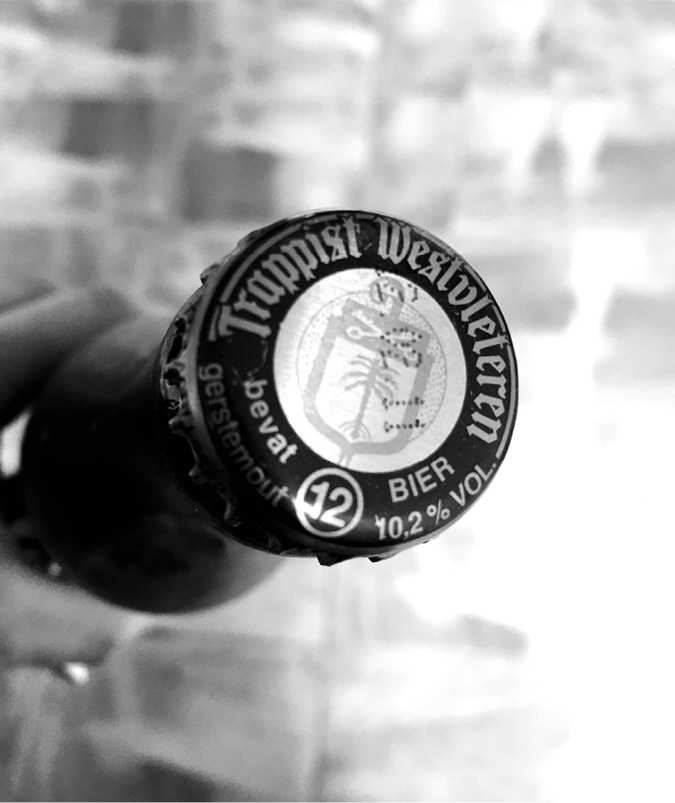
The elusive Westvleteren 12.
Styles vary, but, for the most part, expect to find at least a Dubbel and a Tripel at most of them. Dubbels very often are malty and brownish with notes of dark fruit (figs, dates, raisins, you name it) and are usually around 7.5 percent alcohol by volume. Tripels can be dark, but the better-known ones, particularly Westmalle Tripel, are more of a medium amber and are markedly dryer than the Dubbels. Expect them to be around 9 percent ABV.
The brothers’ beer-making tradition reaches back centuries. Back in the day, the monks would often produce beer mostly for their own consumption (and for fundraising as well), and their brews were frequently their sole form of sustenance during heavy fasting periods. In the Middle Ages, it was a lot safer to drink beer than it was water (it was boiled, after all), so it was also the brotherhood’s hydration substitute.
They are still brewing for their own consumption, but often those beers are a bit milder than the high-ABV stuff the public drinks (just over 6 percent is common). Proceeds from the commercially available brews support the abbeys and frequently fund infrastructure renovations and other improvements.
Abbey Ales
Abbeys and Belgian beer, well beyond just the Trappist offerings, are inextricably linked. Monks are very frequently part of the logos and general trade dress of brands that have no modern connection to abbeys. Often these brands’ styles are similar to the Trappists’ output, even if they’re produced and marketed by laypeople.
That’s not to say monks are completely out of the equation with all non-clergy-produced abbey-style beers. A commercial brewery might have an arrangement with a particular monastery.
That’s the dynamic behind Maredsous, the name of which Duvel Moortgat licenses from the Maredsous Benedictine abbey. The Puurs, Belgium-based brewery first started making the brand in 1963 and today produces Maredsous Blonde, Brune, and Triple.
The St. Bernardus Brewery in the town of Watou used to have a similar deal with an actual Trappist monastery. Between 1946 and 1992, St. Bernardus was licensed by the monks at St. Sixtus to brew products under that abbey’s name. When the order agreed in 1992 that Trappist beers may only be brewed inside an actual Trappist monastery, St. Bernardus continued to brew, but it now markets its products under its own name. The brewery’s brands, which include St. Bernardus Tripel, St. Bernardus Pater 6, St. Bernardus Prior 8, and St. Bernardus Abt 12, are quite well known and respected in their own right. St. Sixtus, meanwhile, produces the often hard-to-find Westvelteren Trappist range, whose elusiveness (with a few exceptions, it’s usually only available for purchase at the abbey) has led to all sorts of Westvleteren hoarding and horse-trading among beer geeks.
The Augustijn brand, whose labels feature a monk stirring wort with a large paddle, claims a heritage dating all the way back to 1295. That’s when the brand’s modern brewery, Brouwerij Van Steenberge, says the Augustinian friars commenced their beer-making activities at their monastery in the Flemish city of Ghent. In the late 1970s, the brotherhood hooked up with Van Steenberge, which has been brewing Augustijn in its current iteration since 1982. Today, Van Steenberge brews Augustijn Blond, Dark, and Grand Cru. In 2011, Van Steenberge’s beers became available to an even wider audience as it signed a worldwide distribution agreement with global brewing behemoth SABMiller.

Brasserie Dupont.
Speaking of gargantuan multinational beer marketers, the monk-free abbey-style ale that is perhaps best known among mainstream drinkers is Leffe, which is owned, in its twenty-first century form, by Anheuser-Busch InBev. The story Leffe’s owners like to tell traces the brand’s origins to about 1240. That’s the year that the brothers at the Notre-Dame de Leffe abbey constructed their first brewery, whose products helped stave off all sorts of nasty pestilences—particularly the Black Plague—transmitted through unsanitary water.
The abbey thrived for centuries before the French Revolution forced it to shutter, and it didn’t reopen until nearly a century and a half later in 1929. It resumed its brewing operations about a quarter-century later and ultimately ended up in the hands of what would become AB InBev. Needless to say, the large industrial brewing conglomerate has no modern connection with an abbey of any kind.
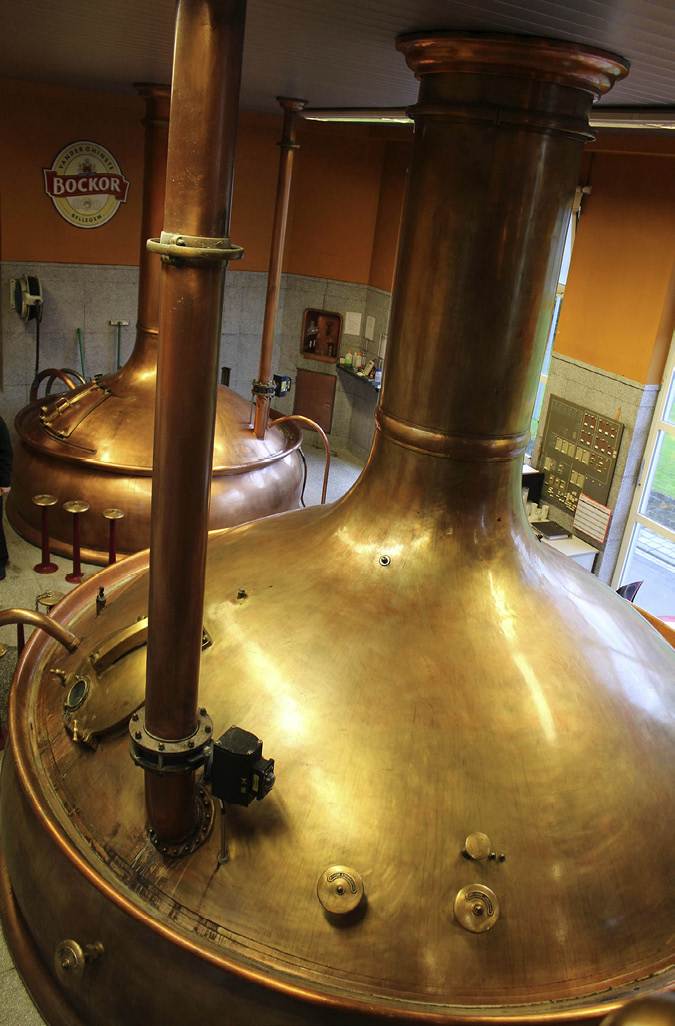
Some eye-catching copper at Brouwerij Omer Vander Ghinste.
Farmhouse Ales
As highly romanticized as monastic imagery has become, the monks aren’t the only ones who have defined Belgian brewing. The farming community has played an equally important role, and the style most closely associated with the rural agricultural lifestyle is the saison, the name of which is based on the French word for “season.” It’s brewed in one saison and consumed in another.
The farmers had to do something to occupy their time and supplement their livelihood when the land was completely dead in winter, so they brewed beer with the grains they accumulated during the recent harvest. When summer came and it was time for the heavy field work, the farm workers had plenty to drink. Belgium has American craft brewers to thank for helping to keep the style alive because, much like an agricultural economy, saisons had become in danger of being relegated to the past. But there are many breweries in Belgium, particularly in the French-speaking Wallonia region, that have kept the style alive throughout the decades. The most famous of those is Brasserie Dupont, whose Saison Dupont has been brewed in one form or another since 1844. The 6.5 ABV beer—a typical strength for the style, but they have been known to be slightly higher or lower in alcohol—pours a deep straw-like blonde and boasts both a pronounced citrusy bitterness and a grainy breadiness, with a touch of wild, yeasty funk.
A much newer Wallonia brewery that produces a popular interpretation of the classic style is Brasserie Fantome, known for its flagship brew, Fantome Saison (look for the label with the rather impish-looking ghost on it). The brewery opened in 1988, a time when American craft beer was just in its infancy and most stateside producers had yet to fully discover the style.
Lambic Country
One can’t discuss Belgian brewing without mentioning one of its most strikingly original styles, lambic. Produced in a region within about a forty-five minute drive of Brussels, lambic and its sister style, gueuze, have become something of a connoisseur’s style. In their rawest form, they’re not the most approachable of ales; their claim to fame is spontaneous fermentation, in which ambient microorganisms native to the region do all of the sugar-to-alcohol heavy lifting. The process results in a complex and intensely sour beer that’s fairly off-putting for first-time drinkers (and for many seasoned ones as well). That’s why the bulk of their commercial volume is from fruit-enhanced beers. One of the more popular producers is Lindemans, which is best known for Lindemans Framboise, a raspberry lambic. The fruit masks a lot of the style’s funkier elements.
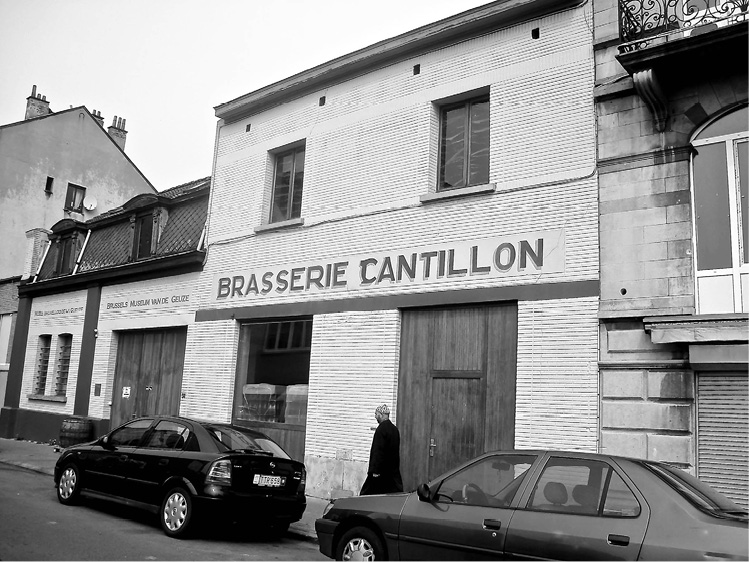
The legendary Cantillon brewery.
On the outskirts of Brussels lies the Cantillon brewery, which has become one of the biggest destinations for international beer pilgrims. (It’s a wonder that any of them find it because it’s so unassuming on a tight urban side street. Cantillon’s legend makes it seem larger than life. One expects to find a cross between a rustic farmhouse and the Parthenon, with Hollywood red-carpet-style spotlights swinging back and forth in front of it. The façade is deceptively unimpressive.)
The most appealing element of the Cantillon brewery, aside from getting to taste its very tart lambic and gueuze (a blend of young and old lambics) offerings, is the self-guided tour that lets visitors stroll through a portal into the past. Among the sights one can behold are ancient-looking fermentation tanks, along with dust and cobwebs strewn throughout the room. No, this isn’t a poorly maintained museum; it’s an actual, functioning brewery. The abandoned-attic motif attracts the type of ambient microbes that give lambic its wild character.
Stylistic Revival
The amazing aspect of many of the styles we traditionally think of as Belgian would be all but lost to history if it hadn’t been for the encroachment of industrial lagers. When pilsener-style lagers were invented in the nineteenth century, they quickly swept Europe and became the world’s dominant style. By the middle of the twentieth century, it became difficult for family-owned Belgian breweries to compete when the big guys were making pils far more efficiently and on a much grander scale. It was around that time that many of those independent operations began reaching back into their respective pasts for styles that were very specific to their immediate regions but were all but extinct. (The Trappist and other abbey brewers, for the most part, have always been making their traditional styles because they didn’t have to compete commercially with Big Beer; ditto with the core lambic producers.)
Pils is still the dominant style throughout Belgium; keep in mind that Stella Artois is Belgian, and it’s a huge mass-market brand. It’s easy to see that from Stella is where much of the pils volume is coming from, especially when you consider the fact that it’s owned by the largest brewery in the world, Anheuser-Busch InBev.
It’s the hovering presence of global behemoths like AB InBev that has made export a huge component of the independent breweries’ business models. On average, the indies export about 60 percent of their output; some go as high as 80 percent.
Belgian beer has become so popular abroad that many breweries in the United States, Italy, Scandinavia, Japan, Korea, Hong Kong, and other parts of Asia are adapting the classic styles and developing products that, in a lot of ways, rival the originals. The independent brewers of Belgium saw that happening and, while they were honored that their traditions have inspired so many around the world (imitation is the sincerest form of flattery, after all), they became wary of the competition. In 2007, the owners of some of those breweries teamed up and created Belgian Family Brewers, a nonprofit federation of twenty-one producers from across Wallonia and Flanders—about 15 percent of all of the country’s breweries—whose aim is to promote historic, independent family operations. The member breweries created a Belgian Family Brewers seal, which appears on their products and is designed to be a mark of artisanal quality. More importantly, it distinguishes the members’ products from the thousands of imitations on the market worldwide.
Longevity is a prerequisite for membership; in order for a brewery to be eligible to join, it must have at least fifty years of continuous production under its belt. To put that into perspective, if American craft brewers had to meet the same criterion, there would be three members: Anchor, Yuengling, and August Schell.
Most of the members have far more brewing experience than that bare minimum. Collectively, the twenty-one members represent some 3,500 years of beer-making history. There are even a few that go back ten generations to about the fifteenth century.
What’s most amazing about the organization is that it didn’t launch until the latter part of the last decade. When dealing with centuries of familial pride, there are a lot of egos at play; some families don’t always play well with others. That’s what makes the fact that such an endeavor exists all the more remarkable.
Other Belgian Breweries of Note
It’s a daunting task to narrow down Belgium’s bounty to just a handful of breweries. Volumes upon volumes have been written about the inextricable link between the small country and its most prized beverage. But here are a few that are fairly renowned.
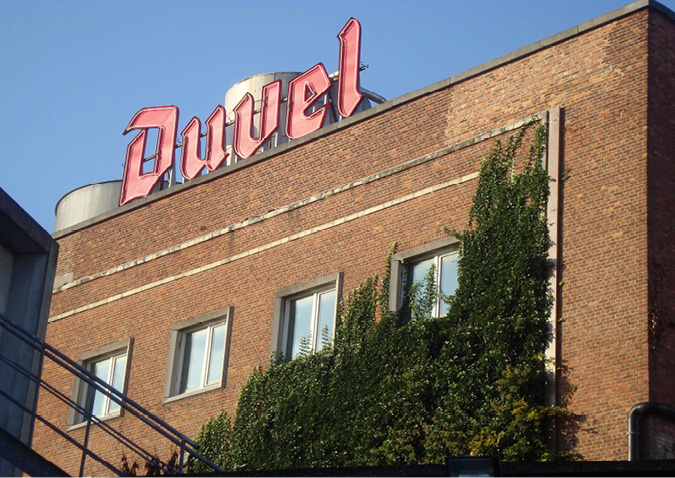
The Duvel Moortgat brewery.
Duvel Moortgat
Duvel Moortgat is one of the largest of the family-owned breweries. Its annual output is around a half-million barrels (for some perspective, that’s only about half the output of a US craft operation like New Belgium), and in recent years much of its growth has come from acquisition. However, its acquisitions are not the same as those that have made the macros, well, macros. Duvel Moortgat hasn’t been intent on driving the competition from the market but rather has attempted to preserve the heritage of some well-respected, classic Belgian brands that may have vanished or been absorbed by much larger companies in whose portfolios they wouldn’t get the attention they deserve. Liefmans and Brasserie d’Achouffe are among those. But it was the brewery’s purchase of iconic Antwerp brewery De Koninck (founded in 1833) in 2010 that best illustrated what Duvel’s been doing—or rather how previous owner Modeste Van den Bogaert characterized the company’s strategy: “The company wasn’t in really good shape and Heineken was going to acquire it and, indeed, [Van den Bogaert] said ‘I’m not even selling it, I’m lending it to you so you could continue the legacy of my brewery,’” noted Duvel Moortgat chief operating officer Daniel Krug, who reports to current CEO Michel Moortgat. (The Moortgat family still owns about two-thirds of the business; the remaining shares are publicly traded.)
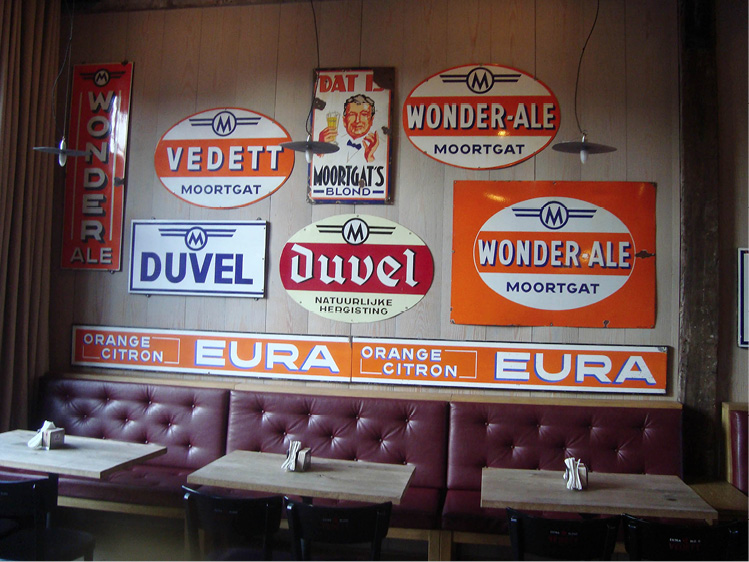
Vintage brand signage in Duvel Moortgat’s tasting room.
While Duvel Moortgat has helped reinvigorate and grow many of the brands the company has acquired—it turned 20,000-barrel d’Achouffe into a 200,000-barrel business in the space of a decade—it’s the home-grown brand that’s now half of the parent company’s name that really made Duvel Moortgat famous.
In 1871, Jan-Léonard Moortgat and his wife founded what was originally called the Moortgat Brewery. About a half-century later, Duvel strong golden ale debuted. (A tale the brewery likes to tell is that a local shoemaker in the company’s home town of Breendonk tasted it and declared that the 8.5 percent brew was a real “duvel,” meaning devil.)
The brand has attracted many imitators (many of which also have devilish names), but the strong golden ale—best enjoyed in a tulip glass that facilitates its huge, billowing head—approaches the century mark as the one to beat.
The Duvel Moortgat family of craft breweries extends to the United States as well. It now owns Cooperstown, New York’s Brewery Ommegang (acquired in 2003), Kansas City’s Boulevard (acquired in 2013), and Paso Robles, California’s Firestone Walker (acquired in 2015).
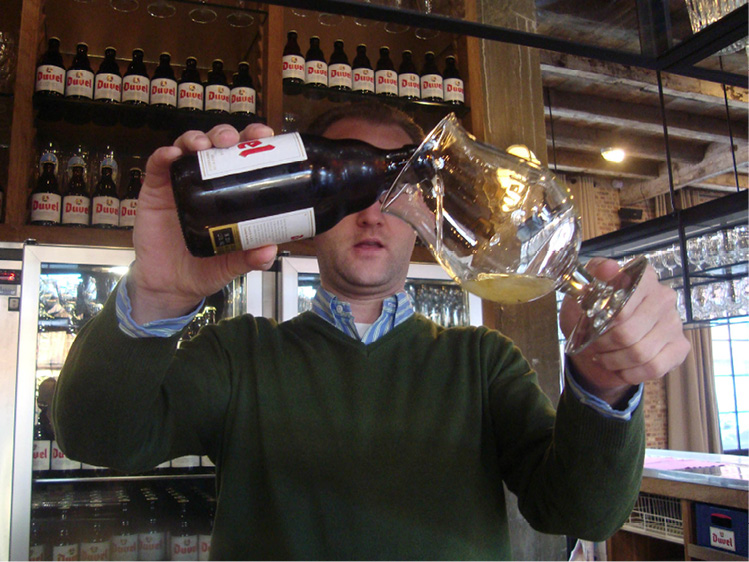
There’s a technique to pouring a good glass of Duvel.
Het Anker
Dutch for “The Anchor,” Het Anker, which is located in the charming little city of Mechelen, is a destination in every sense of the word. For one thing, it has its own hotel attached to the brewery, which makes visiting (and drinking) that much easier. There’s also a full-service restaurant where diners can enjoy fine Flemish and continental fare—its best during the fall and winter months when it’s stew season! The first brewery at the site can be traced way back to 1471 and was founded by Beguines, a semi-monastic religious order of laypeople. Hit the fast-forward button to four hundred years later, and the Van Breedam family bought the brewery and modernized it (by late nineteenth-century standards). From the outside, the facility still resembles an industrial building of the period, with an Anker-branded smokestack piercing the sky, recalling its steampunk history (it’s mostly ornamental now). Its most famous brand is Gouden Carolus Classic (“Golden Charles”), a dark copper-colored, malt-forward, warming 8.5 percent ale. It also brews Gouden Carolus Tripel, much paler in color but slightly higher in alcohol at 9 percent ABV. Recognizing worldwide beer lovers’ gravitation toward all things hoppy, the brewery released Hopsinjoor, a brew that has five kinds of hops and is markedly more bitter than the types of beers Belgians have traditionally made.
Brouwerij Huyghe
History suggests that a brewery existed at the site of what is now the Brouwerij Huyghe since the mid-seventeenth century. But it was in 1906 that Léon Huyghe bought the brewery in the town of Melle and the site began to evolve into its current form. Two World Wars and economic ups and downs took their toll on Brouwerij Huyghe, as they did on most operations throughout the region, but the business persevered. What is perhaps the biggest milestone in the brewery’s existence occurred in 1988 when it launched the beer for which it is world famous: Delirium Tremens. In fact, the brand is far better known than the name of the brewery itself. Mention Huyghe and you might get a blank stare. Mention Delirium Tremens and eyes are very likely to light up. The 8.5 percent ABV blond ale, easily identified by its pink elephant icon (and, when it’s in packaged form, by its slightly speckled, opaque, off-white bottle with blue foil neck trim), has a great deal going on, flavor- and aroma-wise: a slight malt sweetness complements a veritable garden of spicy and floral notes.
The brewery itself represents Belgium in a nutshell. It’s got all of the shiny, new high-tech equipment and automated systems required to run a truly modern operation, but, as a counterpoint, its old-school, 1930s-era tiled brew house with all sorts of coppery goodness remains. One foot in history and the other in the future. That’s what Belgian brewing is all about.
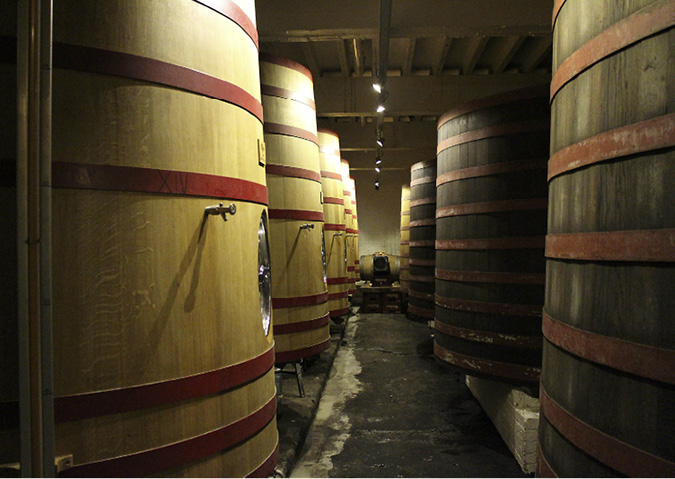
An array of foeders (or foudres, if you prefer the French spelling).
Omer Vander Ghinste/Brouwerij Bockor
Brouwerij Omer Vander Ghinste, in the South West Flemish village of Bellegem, got its start in 1892 and launched its most widely consumed brand, Bockor Pils, in the 1930s (the brewery would take the name Brouwerij Bockor four decades later). Sure, it’s a pilsner; most commercial Belgian brewers jumped on the pale lager train when it swept the continent. However, in the 1970s, Omer Vander Ghinste solidified its legend when it began producing its notable fruit beers in earnest under the Jacobins label. In 1970 the brewery launched Jacobins Gueuze, thirteen years later it unveiled Jacobins Kriek (a cherry beer) and, three years after that, it released its first batches of Jacobins Framboise (raspberry). But if there’s ever been a white whale about which Belgophiles rhapsodize most heartily, it’s Cuvée des Jacobins, a Flemish sour ale that’s aged for at least eighteen months in large oak vats known as foeders. (That’s the Dutch spelling in Flanders; French speakers spell it ‘foudre.’) The foeder/foudre room at Bockor is a dimly lit wonderland of wild, sour, and fruity aromas from which visitors usually have to be dragged kicking and screaming. There’s no experience that’s comparable to drinking Cuvée des Jacobins fresh from the wood.
But there’s plenty to love for those who don’t like fruit beers, sours, or pilsners. In 2008 the brewery launced Omer, a blond ale that’s a great entry point brew for those new to the Belgosphere.
Brouwerij Roman
Remember that brewery that’s been around since the fifteenth century and is now in its fourteenth generation? That would be Brewery Roman, located in the village of Mater in the city of Oudenaarde. According to the brewery, Mater has been the home to the Roman family’s brewing exploits since 1545. Buildings have come and gone, and the product lines have changed quite a bit in the subsequent four and three-quarters centuries. Its modern offerings include the Ename brand of abbey-style beers, featuring a blond, a dubbel, a tripel, and a rouge. The brand gets its name from the Abbey of Ename in the nearby town that bears its name. Historians place the abbey’s origins in the nineth century AD; the Benedictines moved in a couple of centuries later in 1063. In the 1990s, the brewery sponsored the excavation of the site and began producing the Ename line at that time. Another one of its popular lines is Adriaen Brouwer, named after the painter who was born in Oudenaarde in 1605. Adriaen Brouwer proper is a sessionable 5 percent ABV brown ale, while Adriaen Brouwer Dark Gold is a much more potent 8.5 percent.
Brasserie Dubuisson
You can probably tell by the name of this one that we’ve moved out of Dutch-speaking Flanders and into French-speaking Wallonia. Age-wise, Dubuisson lies in the middle of the truly ancient Brouwerij Roman and the late nineteenth-century-born Bockor. Joseph Leroy, an ancestor of modern owner Hugues Dubuisson, opened the brewery in 1769. In the 1930s, the brewery unveiled what would become its flagship: Bush Beer. The management team chose an English name because English beers were in fashion at the time, and “buisson” is actually French for “bush” (“du” is a modifier). The line includes Bush Amber, Triple, and Noël, its Christmas seasonal. Unless you’re actually going to Belgium, don’t expect to find a beer called “Bush.” Oh, it’s quite easy to find in the states, mostly at places that specialize in Belgian brews or, more generally, high-end imports. However, in these parts, it’s a little challenging to try to sell a premium beer whose name sounds an awful lot like “Busch.” (And, you know, lawyers.) When the beers are exported out of Belgium, they’re marketed as Scaldis. Scaldis Amber has an incredibly assertive ABV of 12 percent. There have been some bars selling it that have marketed it as “the strongest beer in the world.” That was true up until about the late 1970s, but they continued to do so well into the 2000s, and that’s just dishonest. And, besides, it’s an amazingly complex brew in its own right. The Dubuisson brewers would make a quality beer at any strength.
American Trappist
Think you have to travel to Belgium or the Netherlands to drink beer freshly brewed by Trappist monks? Think again. As of 2014, there’s an operating Trappist monastery on American soil—in New England to be exact. The brotherhood at the St. Joseph’s Abbey in Spencer, Massaschusetts, started brewing mostly out of necessity. For six decades the primary commercial enterprise in which the abbey was engaged was crafting and packing jams under the Trappist Preserves label. In an effort to step up their charitable endeavors and sustain their own community for generations to come, the monks found inspiration in the success of their European brethren’s beer-making exploits. One of the brothers in particular had been bitten by the brewing bug and trained at a local brewery. Soon, a contingent of St. Joseph’s brothers traveled across Belgium, dropping in on the storied Trappist breweries in the country and learning the trade from the likes of St. Sixtus (Westvleteren) and Westmalle. Today, the Masschusetts monks market the fruits of their labor under the deceivingly simple Spencer label.